Practice Free AZ-305 Exam Online Questions
The accounting department at your company migrates to a new financial accounting software. The accounting department must keep file-based database backups for seven years for compliance purposes. It is unlikely that the backups will be used to recover data.
You need to move the backups to Azure. The solution must minimize costs.
Where should you store the backups?
- A . Azure Blob storage that uses the Archive tier
- B . Azure SQL Database
- C . Azure Blob storage that uses the Cool tier
- D . a Recovery Services vault
A
Explanation:
Azure Front Door enables you to define, manage, and monitor the global routing for your web traffic by optimizing for best performance and instant global failover for high availability. With Front Door, you can transform your global (multi-region) consumer and enterprise applications into robust, high-performance personalized modern applications, APIs, and content that reaches a global audience with Azure.
Front Door works at Layer 7 or HTTP/HTTPS layer and uses anycast protocol with split TCP and Microsoft’s global network for improving global connectivity.
Reference: https://docs.microsoft.com/en-us/azure/frontdoor/front-door-overview
HOTSPOT
You have five .NET Core applications that run on 10 Azure virtual machines in the same subscription.
You need to recommend a solution to ensure that the applications can authenticate by using the same Azure Active Directory (Azure AD) identity.
The solution must meet the following requirements:
✑ Ensure that the applications can authenticate only when running on the 10 virtual machines.
✑ Minimize administrative effort.
What should you include in the recommendation? To answer, select the appropriate options in the answer area. NOTE: Each correct selection is worth one point.


You have data files in Azure Blob Storage.
You plan to transform the files and move them to Azure Data Lake Storage.
You need to transform the data by using mapping data flow.
Which service should you use?
- A . Azure Data Box Gateway
- B . Azure Databricks
- C . Azure Data Factory
- D . Azure Storage Sync
C
Explanation:
You can use Copy Activity in Azure Data Factory to copy data from and to Azure Data Lake Storage Gen2, and use Data Flow to transform data in Azure Data Lake Storage Gen2.
Reference: https://docs.microsoft.com/en-us/azure/data-factory/connector-azure-data-lake-storage
You have to design a Data Engineering solution for your company. The company currently has an Azure subscription. They also have application data hosted in a database on a Microsoft SQL Server hosted in their on-premises data center server. They want to implement the following requirements Transfer transactional data from the on-premises SQL server onto a data warehouse in Azure. Data needs to be transferred every day in the night as a scheduled job
A managed Spark cluster needs to be in place for data engineers to perform analysis on the data stored in the SQL data warehouse. Here the data engineers should have the ability to develop notebooks in Scale, R and Python.
They also need to have a data lake store in place for the ingestion of data from multiple data sources Which of the following would the use for hosting the data warehouse in Azure?
- A . Azure Data Factory
- B . Azure Databricks
- C . Azure Data Lake Gen2 Storage accounts
- D . Azure Synapse Analytics
HOTSPOT
You design a solution for the web tier of WebApp1 as shown in the exhibit.
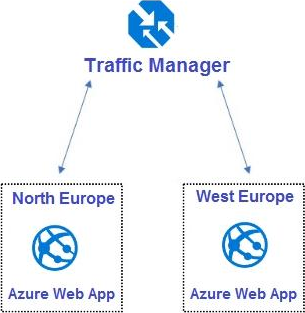
For each of the following statements, select Yes if the statement is true. Otherwise, select No.


Explanation:
Box 1: Yes
Any new deployments to Azure must be redundant in case an Azure region fails.
Traffic Manager uses DNS to direct client requests to the most appropriate service endpoint based on a traffic-routing method and the health of the endpoints. An endpoint is any Internet-facing service hosted inside or outside of Azure. Traffic Manager provides a range of traffic-routing methods and endpoint monitoring options to suit different application needs and automatic failover models. Traffic Manager is resilient to failure, including the failure of an entire Azure region.
Box 2: Yes
Recent changes in Azure brought some significant changes in autoscaling options for Azure Web Apps (i.e. Azure App Service to be precise as scaling happens on App Service plan level and has effect on all Web Apps running in that App Service plan).
Box 3: No
Traffic Manager provides a range of traffic-routing methods and endpoint monitoring options to suit different application needs and automatic failover models. Traffic Manager is resilient to failure, including the failure of an entire Azure region.
Reference:
https://docs.microsoft.com/en-us/azure/traffic-manager/traffic-manager-overview
https://blogs.msdn.microsoft.com/hsirtl/2017/07/03/autoscaling-azure-web-apps/
HOTSPOT
You have an on-premises file server that stores 2 TB of data files.
You plan to move the data files to Azure Blob storage in the Central Europe region.
You need to recommend a storage account type to store the data files and a replication solution for the storage account.
The solution must meet the following requirements:
✑ Be available if a single Azure datacenter fails.
✑ Support storage tiers.
✑ Minimize cost.
What should you recommend? To answer, select the appropriate options in the answer area. NOTE: Each correct selection is worth one point.
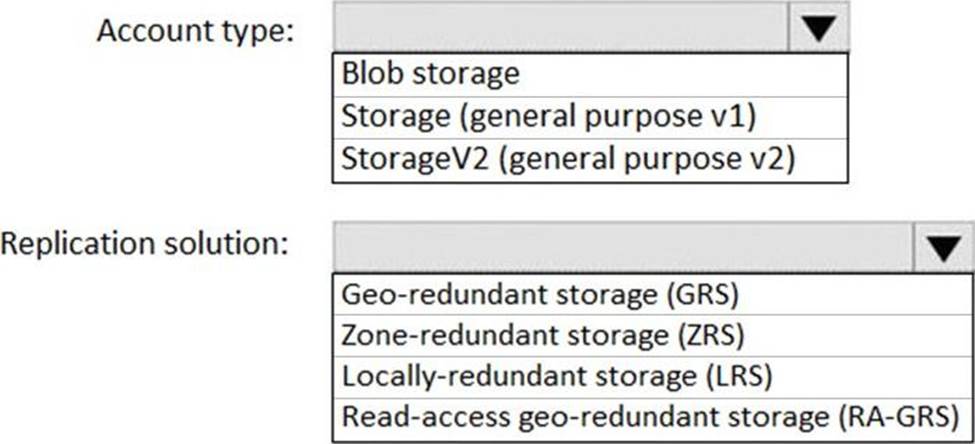

Explanation:
Account Type: StorageV2
Replication solution: Zone-redundant storage (ZRS)
HOTSPOT
You plan to create an Azure Storage account that will host file shares. The shares will be accessed from on-premises applications that are transaction-intensive.
You need to recommend a solution to minimize latency when accessing the file shares. The solution must provide the highest-level of resiliency for the selected storage tier.
What should you include in the recommendation? To answer, select the appropriate options in the answer area. NOTE: Each correct selection is worth one point.

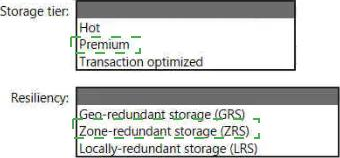
Explanation:
Box 1: Premium
Premium: Premium file shares are backed by solid-state drives (SSDs) and provide consistent high performance and low latency, within single-digit milliseconds for most IO operations, for IO-intensive workloads.
Box 2: Zone-redundant storage (ZRS):
Premium Azure file shares only support LRS and ZRS.
Zone-redundant storage (ZRS): With ZRS, three copies of each file stored, however these copies are physically isolated in three distinct storage clusters in different Azure availability zones.
Reference: https://docs.microsoft.com/en-us/azure/storage/files/storage-files-planning
A company has an on-premises file server cbflserver that runs Windows Server 2019. Windows Admin Center manages this server. The company owns an Azure subscription. You need to provide an Azure solution to prevent data loss if the file server fails.
Solution: You decide to register Windows Admin Center in Azure and then configure Azure Backup.
Would this meet the requirement?
- A . Yes
- B . No
A
Explanation:
Topic 5, Misc. Questions
HOTSPOT
You are designing a storage solution that will ingest, store, and analyze petabytes (PBs) of structured, semi-structured and unstructured text data. The analyzed data will be offloaded to Azure Data Lake Storage Gen2 for long-term retention.
You need to recommend a storage and analytics solution that meets the following requirements:
• Stores the processed data
• Provides interactive analytics
• Supports manual scaling, built-in autoscaling. and custom autoscaling
What should you include in the recommendation? To answer, select the appropriate options in the answer area. NOTE Each correct selection is worth one point.
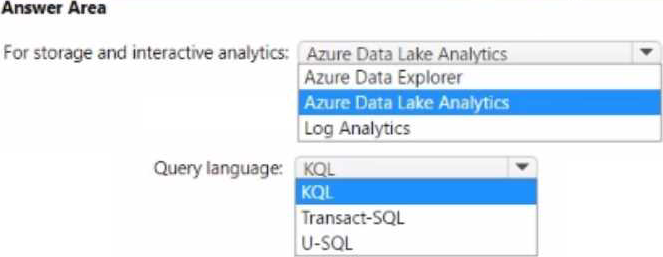
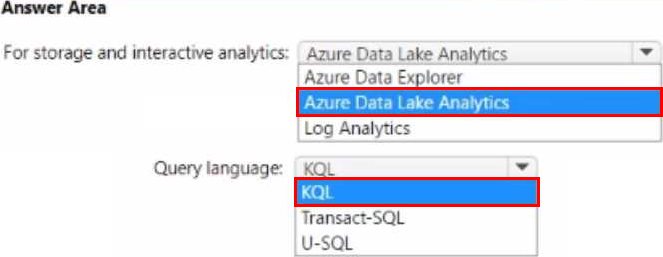
You have an on-premises Microsoft SQL server named SQLI that hosts 50 databases.
You plan to migrate SQL 1 to Azure SQL Managed Instance.
You need to perform an offline migration of SQL 1. The solution must minimize administrative effort.
What should you include in the solution?
- A . SQL Server Migration Assistant (SSMA)
- B . Azure Migrate
- C . Data Migration Assistant (DMA)
- D . Azure Database Migration Service
D
Explanation:
This Azure service supports migration in the offline mode for applications that can afford downtime during the migration process. Unlike the continuous migration in online mode, offline mode migration runs a one-time restore of a full database backup from the source to the target
https://learn.microsoft.com/en-us/azure/azure-sql/migration-guides/managed-instance/sql-server-to-managed-instance-overview?view=azuresql#compare-migration-options
